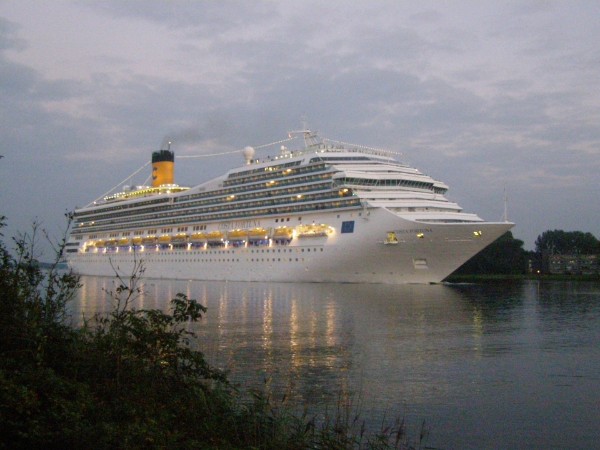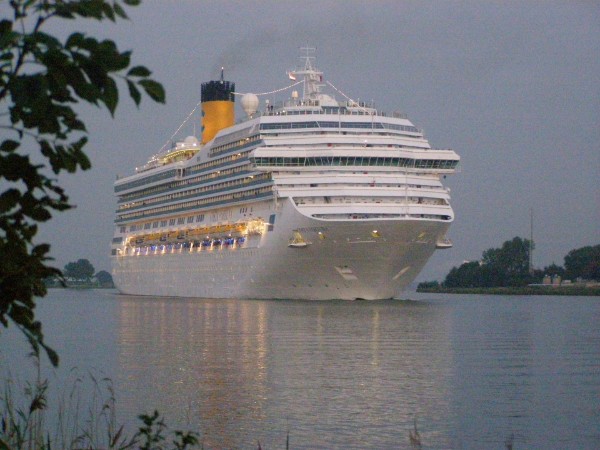Costa Fortuna
In 1996, Carnival Cruise Lines crossed the magical border of a ships tonnage measurement when they crossed the 100.000 tons with the Carnival Destiny. At just over 101.000 tons, the ship was of course the largest passengership ever built and she started the trend towards even larger ships that we had seen in the 1990's. Just one decade earlier, the Norway had been the largest cruiseliner in service with her 76.000 tons she almost exceeded the Cunard Queens from the 1930's/ 1940's. Nowadays, building a 100.000 ton cruiseliner means you built a midsize ship and the trend now is towards 160.000 tons.
Below, Costa Fortuna is seen sailing past Velsen-Noord after her first visit to Amsterdam at the 2nd of september 2014.

Costa Fortuna was the fourth ship of a class of five. Before her, after Carnival Destiny in 1996, came Carnival Triumph in 1999 and Carnival Victory in 2000. In 2003, Costa Magica followed as the last in the class. It was the first time that Carnival introduced a shipclass that was divided between Carnival and Costa. Costa Fortuna herself was floated out at the 11th of january 2002 at the Fincantieri wharf at Genoa, Italy and afterwards she was completed at Sestri Ponente. Her yardnumber was 6086 and she measured 102.587 tons. Her lenght was 272,20 meters, she was 35,50 meters wide and there was space for 3470 passengers as a maximum in 1358 cabins. From those cabins, 1005 were outside and 464 had a balcony. The ship was driven by two propellers powered by four 16-cylinder and two 12-cylinder diesel engines built by Sultzer-Fincantieri. Her normal service speed is 20 knots.

The ships interiours are inspired by the oceanliners of Italy of yesteryear and the public lounges are named after ships like Rex, Cote di Savoia, Vulcania and Leonardo da Vinci. The decks of the ship are named after the ports that were mostly visited by the Costa fleet when the company still sailed line voyages to South America. Dangling from the ceiling in the ships atrium are the twenty-six models of all passengerships that were operated by Costa in a scale of 1:100 up untill of course Costa Fortuna herself. Of course, Costa Fortuna is the central focus. On the wall, also a large mural is painted. This 'Allegory of the Costa Fleet' was designed by Gianpaolo Amstici and also shows all Costa ships that have carried passengers in the history of the line. On the aft walls of the atrium, bass-reliefs are made in honour of the goddess Fortuna. Being designed by Carnival Cruises house-designer Joseph Farcus, her glittery interiours are of course by no means comparable to that of the liners of the old days, but should that be? Costa Fortuna is a modern ship sailed by modern day passengers needing something else then the linevoyage passengers of the 1930's were needing. Artists who decorated the new ship incudes graphic artist Augusto Vignali and Emanuele Luzzati. Luzzati made reproductions of the advertizing posters of the old liners, that are now decorating the ships restaurants. The liftdoors aboard are decorated with reproductions of advertisements from the 1920's and 1930's designed by Vittorio Accornero and Franz Lenhart. The three deck high Rex Theater is designed with elements remembering this grandest Italian liner of them all. On the walls, the ships funnels are presented and at the sides of the stage, two large bows are visible. On the Buenos Aires deck is an original model of the Michelangelo presented, built in 1965 by Giacomo Patrone. Originally, the model was made for the inauguration of the liner. The model was recovered and restored by Costa and now again is in the public eye after almost 50 years. Furthermore, several other ship models were created especially for Costa Fortuna. As a passengership geek, this modern cruiseliner is a must-see due to all links to the Golden Age of passengertravel.
In august and september of 2003, Costa Fortuna sailed her trials in the Mediterranean and the following 14th of november, she was delivered to Costa as the biggest Italian flagged passengerliner in history. A few days later, at the 18th of november, the ship departed Genoa for an introductionvoyage that took her back to Genoa via Barcelona and Marseilles. She was the first ever European cruiseship that exceeded 100.000 tons, although she never held the title of the largest passengership in service. Carnival Destiny did, but Princess Cruises had introduced the Grand class of 109.000 tons, that had started with Grand Princess in 1998.

Costa inaugurated their new Palacrociere at Savona, which was to be the main terminal for Costa in Italy at the 22nd of november 2003, and also Costa Fortuna was there to be officially named. Her godmother, who smashed the bottle of champagne against her bow, was Maria Grazia Cucinotta (1968). Cucinotta is an Italian actress, who performed in movies like 'The World Is Not Enough' (1999) and 'The Rite' (2011). The terminal itself was opened with a staggering open-air show by Valerio Festi, titled 'Transatlantic Liners: The Art Of Navigation In Italy'. The show was an imaginary voyage where-in the modern liners and the ships from yesteryear were incorporated. Three days later, at the 25th, the Costa Fortuna departed for her real maiden cruise to Spain and Morocco, sailing Mediterranean cruises through summer and Caribbean cruises through winter, the normal scedule for Costa ships.

